Plenty of aquarists get interested in adding saltwater shrimp to their reef tanks.
The variety of colors, patterns, and shapes of these crustaceans make for creative members of community tanks.
If you get the bonus of a cleaner shrimp out of the mix, why not aim for the benefit?
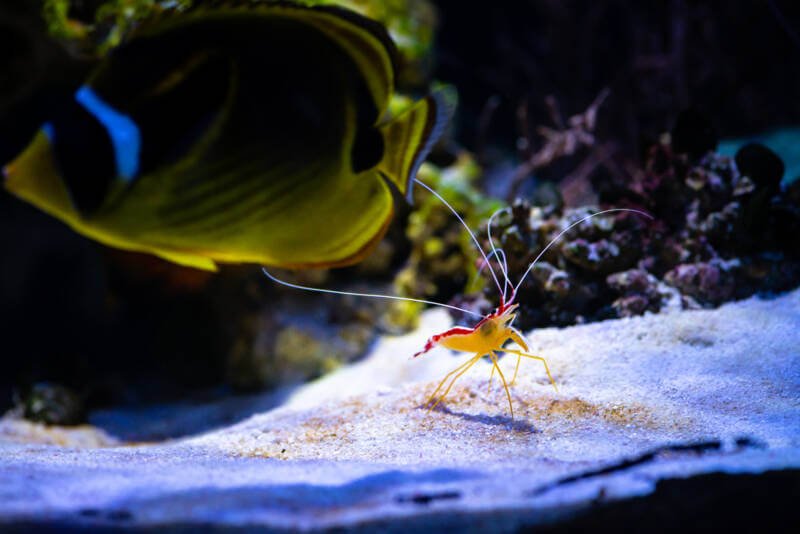
Cleaner shrimp are any species that remove parasites and excess mucus from fish and other invertebrates.
It’s a symbiotic relationship where the fish lose potential sources of infection, and the shrimp gain a handy meal (and don’t need to worry about the fish snacking on them).
There are three families cleaner shrimp belong to:
- Hippolytidae (where you find the fire shrimp, peppermint shrimp, and scarlet skunk cleaner shrimp);
- Palaemonidae (which includes species that bond with sea anemones);
- Stenopodidae (which has the coral banded shrimp).
Difficulty in management depends on the species you choose. Some shrimp have no problem going about their business in peace.
Others need specific lighting, and still, others have special menus (such as starfish).
Before you decide to add cleaner shrimp to your reef tank, make sure you spend some time on homework.
As cool as it is to spy on a crustacean grooming a fish, you want to keep them as happy and healthy as you can. And that may mean keeping the shrimp away from corals.
At a Glance
| Minimum tank size: | 10-55 gallons (38-208 l) |
| School size: | usually best kept alone |
| Temperature: | 73-82°F (23-28°C) |
| Lifespan: | 2-4 years |
| Size: | 2-3 inches (5-7.6 cm) |
| pH: | 8.0-8.2 |
| Ammonia: | 0 ppm |
| Nitrite: | 0 ppm |
| Nitrate: | 0 ppm |
| Specific gravity: | 1.025 |
In this article
In the Wild

The majority of the most popular cleaner shrimp kept in marine aquariums inhabit the Indo-Pacific region.
This is where you’ll find the coral banded shrimp (Stenopus hispidus), fire shrimp (Lysmata debelius), and scarlet skunk cleaner shrimp (Lysmata amboinensis).
But cleaner shrimp inhabit the entire tropical belt of the global ocean.
And peppermint shrimp (Lysmata wurdemanni) hang out on coral reefs throughout the Caribbean. It’s one of the features that sets them apart from their fellow cleaners.
All of these dutiful crustaceans behave similarly. They form “cleaning stations” on the reefs.
The white bands on their legs or antennae serve as an advertisement of their services.
Fish notice the bright shade and swim over to have unwanted pests removed from their scales.
They don’t require the rigors of maintaining a specific sea anemone, nor do they have specific diets of starfish. This makes them more manageable.
Some of the more social members of the cleaning group will also “dance” to attract attention.
Researchers have determined that the faster they move in their swaying, the hungrier the shrimp are. The movement helps to attract the attention of fish in the area.
The Most Popular Cleaner Shrimp
Most aquarists stick to four primary species when they think of cleaner shrimp.
1. Coral Banded Shrimp (Stenopus hispidus)
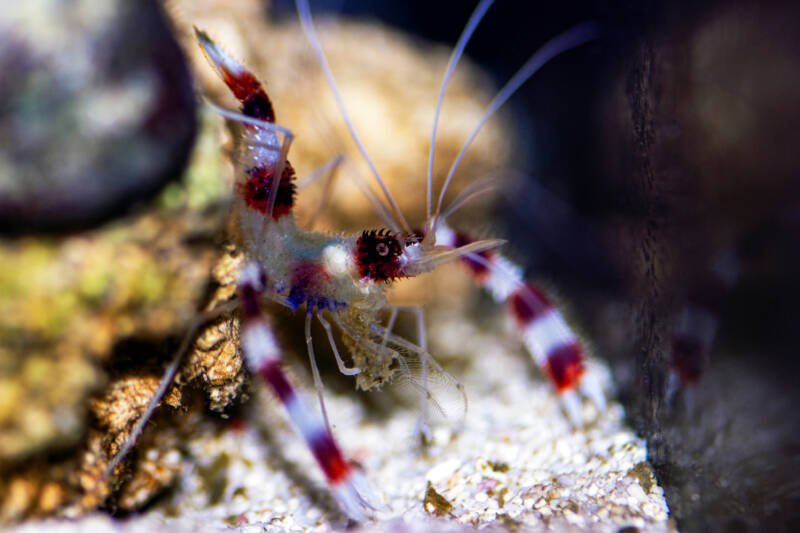
Coral banded shrimp will show up under the names of banded cleaner shrimp, boxer shrimp, and coral banded shrimp.
The distinct red and white bands on their claws make them a popular choice with aquarists.
And where most of the cleaning brigade have smooth shells, you’ll see spiny projections all over the body of a banded shrimp.
It makes them look imposing – as do those claws. However, they’re pretty shy and often spend most of the day hiding among the caves in your tank.
2. Fire Shrimp (Lysmata debelius)
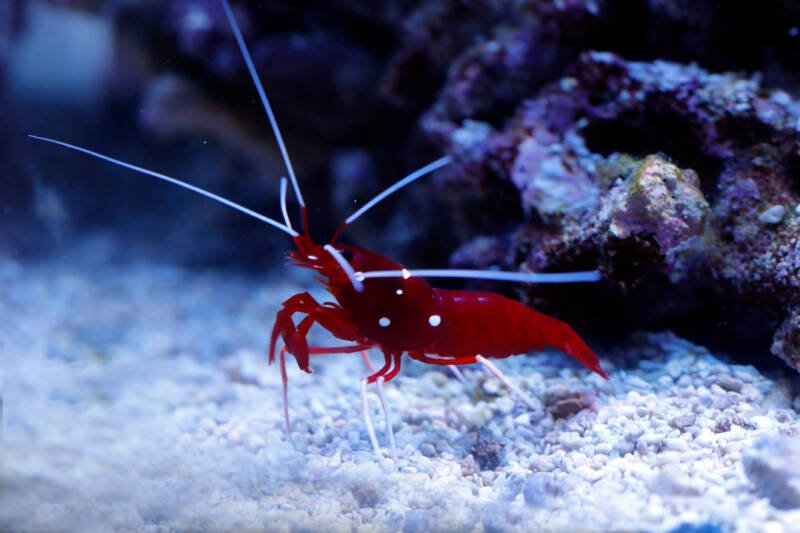
Fire shrimp, or blood-red fire shrimp, top the list in popularity.
The vibrant red color of their carapace makes them stand out against any reef tank setup. It shows up nicely, even under the dim lighting, this species demands to feel comfortable.
You will need to be careful if you add them to a reef tank, though. They have a habit of picking at corals, even when they’re kept suitably fed.
If you have large polyp stony (LPS) or soft polyp stony (SPS) corals you’ve worked hard to cultivate, consider a different shrimp.
3. Peppermint Shrimp (Lysmata wurdemanni)
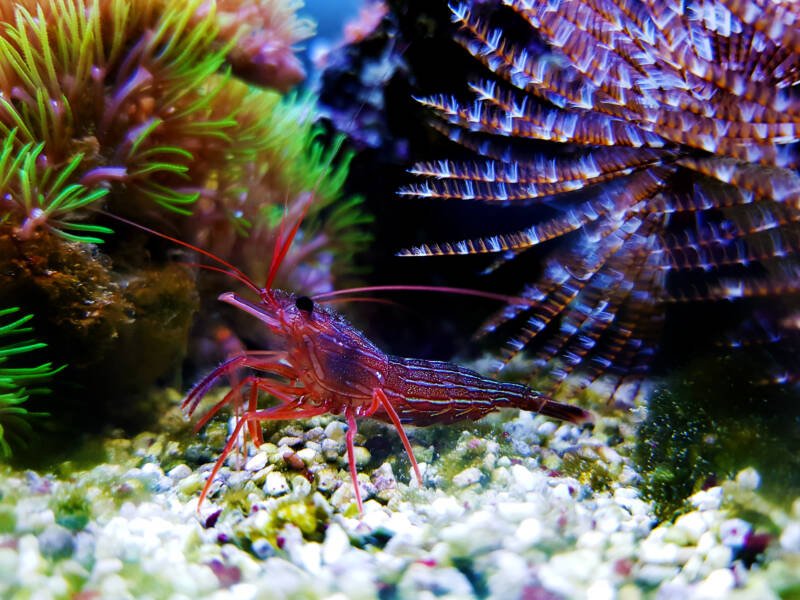
The peppermint shrimp earns a place in saltwater aquaria as the eradicator of the dreaded Aiptasia pest.
They happily consume these sea anemones for you without resorting to harming your other corals or zoanthids at the same time.
With alternating bands of red and white, you’ll also see them listed under the names of candy cane shrimp, Caribbean shrimp, Caribbean cleaner shrimp, and veined shrimp.
They’re on the smaller side, and they prefer to stay anchored to live rock or other stony structures.
4. Scarlet Skunk Cleaner Shrimp (Lysmata amboinensis)

Scarlet skunks are the cleaner shrimp most people think of when they hear the name.
You’ll also see them with the common name of ornamental cleaner shrimp or white-striped cleaner shrimp. And it’s that distinct white stripe down the back that sets them apart.
You’ll see them working all over a fish when they clean. This means climbing into the mouth, too (provided the customer is so accommodating).
And while you may see them take a snip at a coral, it’s not the most common behavior.
Size: Average to Jumbo
Most of the members of the cleaner shrimp group stay under 3 inches (7.6 cm).
This doesn’t include their antennae, of course. And when those feelers extend out to sample the waters (or attract fish in), they appear much larger.
The coral-banded shrimp often confuses people. As members of the Stenopodidae, they’re more closely related to lobsters than the remainder of the cleaner shrimp.
And their hefty front claws show it. It gives them an appearance that they’re bulkier than they actually are.
Cleaner Shrimp Lifespans
For the most part, cleaner shrimp have lifespans between 2-4 years.
However, some aquarists have seen their shrimp survive for up to NINE years.
If you’re willing to provide a healthy diet in a tank with pristine water conditions, you may see similar numbers.
Behaviors

Most cleaner shrimp perform their “grooming” tasks nocturnally. This keeps them safe from toothy predators that might catch them while they’re plying their trade.
You can help them feel more comfortable by providing dim lighting conditions – even during the day.
Even in social, diurnal species, you may not catch a glimpse of your crustaceans.
They’re on the menu of PLENTY of predators. That makes them shy. They’ll hide out in caves or behind live rock formations given a chance.
You can try to encourage your little cleaners to venture into the open by providing plenty of ledges.
With the shadows offering some degree of protection, they may feel comfortable enough to show themselves – to some degree.
Competition between shrimp is standard. And they’re not above attacking one another – within the same species.
You’re better off keeping ONE cleaner shrimp in your reef tank at a time to prevent cannibalism. Otherwise, you’ll want to double your space, so they have plenty of room.
If you do have more than one shrimp in an aquarium, make sure they’re snacking on a tank mate and not a molt before you panic.
As a crustacean, all cleaner shrimp molt every 3-8 weeks. And it’s normal for them to feed on their molted carapace when they’re finished.
Tank Setup
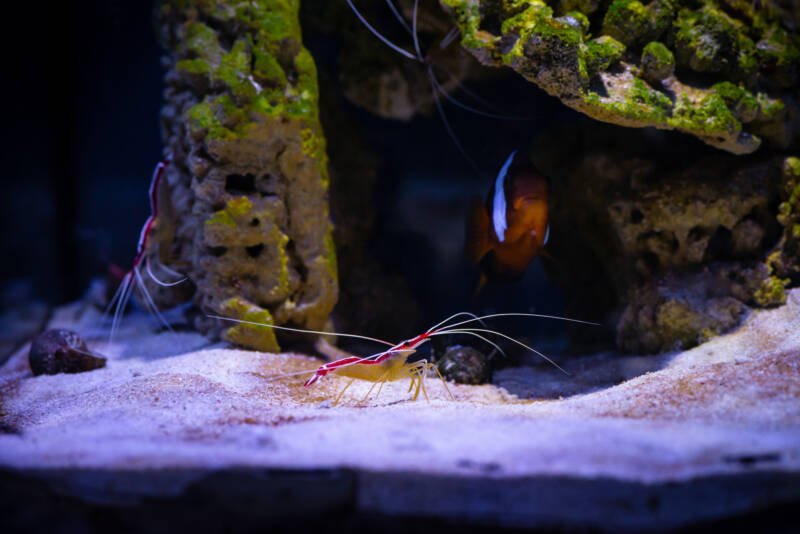
As the smallest in the group, you can get away housing peppermint shrimp in 10-gallon (38 l) tanks – provided you only plan to keep the shrimp. (Where’s the fun of a cleaner shrimp with nothing to clean, though?)
Moving up the scale, coral bandeds will tolerate a 20-gallon (76 l) tank without a problem.
(DON’T keep more than one in an aquarium that size) And then you have scarlet skunks in 30-gallon (113 l) and fires in 55-gallon (208 l) tanks.
No matter what, you want to keep your lighting as dim as possible.
Cleaners don’t tolerate bright light, which may pose a problem if you have a community aquarium with corals or anemones that need specific lighting conditions.
You also need a sturdy lid. It isn’t often that these crustaceans go for a swim, but they CAN climb.
And if they feel stressed for any reason, they’ll look for an escape from the tank. Without a proper cover, you may find a cleaner shrimp on the floor.
Water Conditions
Cleaner shrimp come from tropical regions, and you’ll want to match their individual water temperatures as closely as possible.
This usually falls within the range of 73-82°F (23-28°C). Make sure you consult the needs of your specific species, though.
They prefer their pH range on the basic side of the divide, coming in around 8.0-8.2.
And you should aim to keep the specific gravity close to 1.025.
They’ll tolerate most other dissolved minerals, EXCEPT copper. You can’t have ANY copper in your tank, as it’s toxic to invertebrates.
You also need that water to stay as pristine as possible, so your cleaner shrimp remain healthy.
They have ZERO tolerance for ammonia, nitrites, and nitrates. And since they’re pitching in on removing waste and pests from your tank, the least you can do is give them clean water.
Whenever you perform a water change, you need to make sure you’re introducing an exact match to the tank’s current system.
If you’re not using a RO/DI system, set aside your replacement top-off batch for at least a week. And check the chemistry before you add it to the tank.
Decorating the Cleaner Shrimp Tank
Cleaner shrimp like to feel safe. You can help by providing plenty of rocky overhangs, caverns, and cavities they can retreat within.
Live rock does double-duty by creating natural nooks and crannies while also supplying a ready food source.
You can also add live sand as your substrate. They’ll happily scout along the bottom, plucking bits of nourishment from the grains of sand.
Try to keep as much overhead cover as you can so they don’t feel exposed, though.
Cleaner Shrimp in Communities
Aquarists often add cleaner shrimp to reef tanks to help with waste clean-up.
And the invertebrates are happy to oblige. In addition to retrieving pieces of leftover food from the décor, they remove unwanted pests from their fishy companions.
They’re ideal for adding into community reef tanks. But you need to think carefully about the fish you choose to mix them with.
After all, shrimp appear on the menus of plenty of species. Unless you want to replace your cleaners constantly, you’ll want to think things through.
Tank Mates
Some of the best species to introduce cleaner shrimp with are those most likely to deal with parasites.
Then you’ll get the most benefit from the crustaceans. And making sure they don’t mind sharing a home with shrimp won’t hurt, either.
- Blue tang
- Dwarf angelfish
- Mandarin goby
- Pajama cardinalfish
- Yellow tang.
Incompatible Species
You don’t want to keep cleaner shrimp in a marine aquarium where they’ll have to struggle to avoid predation.
Aggressive species known to feed on shrimp are a BAD combination. This includes:
- Dogface puffer
- Hawkfish
- Lionfish
- Marine betta
- Triggerfish.
Food and Diet
It seems like keeping your cleaner shrimp fed should be an easy task, right?
As long as you have other fish in your reef tank, they shouldn’t need anything else. Well, maybe that live rock with the nooks and crannies could be used as a top-off.
However, these crustaceans can’t survive on their janitorial gleanings alone.
Their tank mates’ mucus, parasites, and dead skin cells won’t provide enough calories to keep them healthy. And those sources don’t offer a complete nutritional base.
It’s essential to provide a well-rounded diet for these carnivores. That means adding in occasional live or frozen proteins to keep them satisfied.
And top cleaner shrimp options include brine shrimp and mysis shrimp. (Remember, they ARE cannibals)
You can also encourage them to take up commercial fish foods. As long as the flakes or sinking pellets come close enough to their antennae for them to sense, they’ll pick up the pieces.
The problem is usually getting the food past the other fish in the tank.
Breeding Cleaner Shrimp: A Challenging Task
It isn’t terribly challenging to breed cleaner shrimp.
If you set up a marine aquarium large enough to accommodate two individuals, you may find a berried shrimp one morning.
The problem comes in that most shrimplets don’t survive to adulthood.
Males or Females? (Or Both?)
Cleaner shrimp fall into a category known as simultaneous hermaphrodites. This means they carry male and female reproductive organs at the same time.
It solves the problem of telling whether you have a male or female (an easy task in freshwater shrimp).
However, there ARE exceptions to the rule. Scarlet skunk cleaner shrimp begin life as males.
ALL shrimplets start male. They don’t develop their female reproductive organs until they’ve undergone several molts.
And that can complicate breeding attempts when ages are uncertain.
Shrimplets on Toast
As every mature cleaner carries the genetic material needed to produce shrimp eggs, it seems like breeding should be an easy process.
And some aquarists luck out, purchasing a berried shrimp. This is a shrimp with eggs visible under the tail.
If you have shrimp eggs, though, you need to take special care to ensure the shrimplets survive to adulthood.
Because EVERYONE (including the parents) love them – as food. They often find themselves snatched up as a snack before they reach their first metamorphosis.
Even worse, the tank itself presents hazards. Shrimplets end up sucked into filter systems and powerheads, with no chance for survival in the equipment.
You need to make special preparations to keep them safe.
Once you’ve rescued them from all possible aquarium threats and sequestered them from fish and corals (and shrimp), you need to raise your shrimplets.
Cleaner shrimp infants are notoriously difficult to feed. There aren’t many success stories.
Cleaner Shrimp Health
Most cleaner shrimp die of shock due to improper acclimation.
While fish may accept a brief introductory period to their new tank environment, these little crustaceans are more delicate.
You need to prepare yourself to spend over an hour adjusting them to your aquarium.
Shrimp acclimation prevents pH shock from taking place.
You need to slowly remove water from their holding container and replace it with tank water every 15 minutes. Failing to do so can cause the invertebrates to die.
You also need to take care when treating any fish ailments.
Read all package ingredients carefully. If you see copper listed, you should transfer the fish to an isolation tank for treatment.
Copper will result in the death of your shrimp (and any other invertebrates).
Cleaner Shrimp: Are They For You?
In general, cleaner shrimp are moderate in cost. But it depends on the species you’re interested in.
Some run as little as $5, while others cost around $35.
And if you choose to investigate some of the rarer species? You could spend several hundred dollars.
The Ocean’s Natural Health and Wellness Crew
Cleaner shrimp assist with keeping your fish and aquarium healthy and free of pests.
And as long as you do your homework and provide the proper living conditions (and low lighting), you’ll find yourself with a happy crustacean. It’s a symbiotic relationship that benefits everyone.
Do you keep cleaner shrimp? Which species are your favorites?
Have you managed to breed cleaner shrimp successfully?
Share your stories and questions with us here!